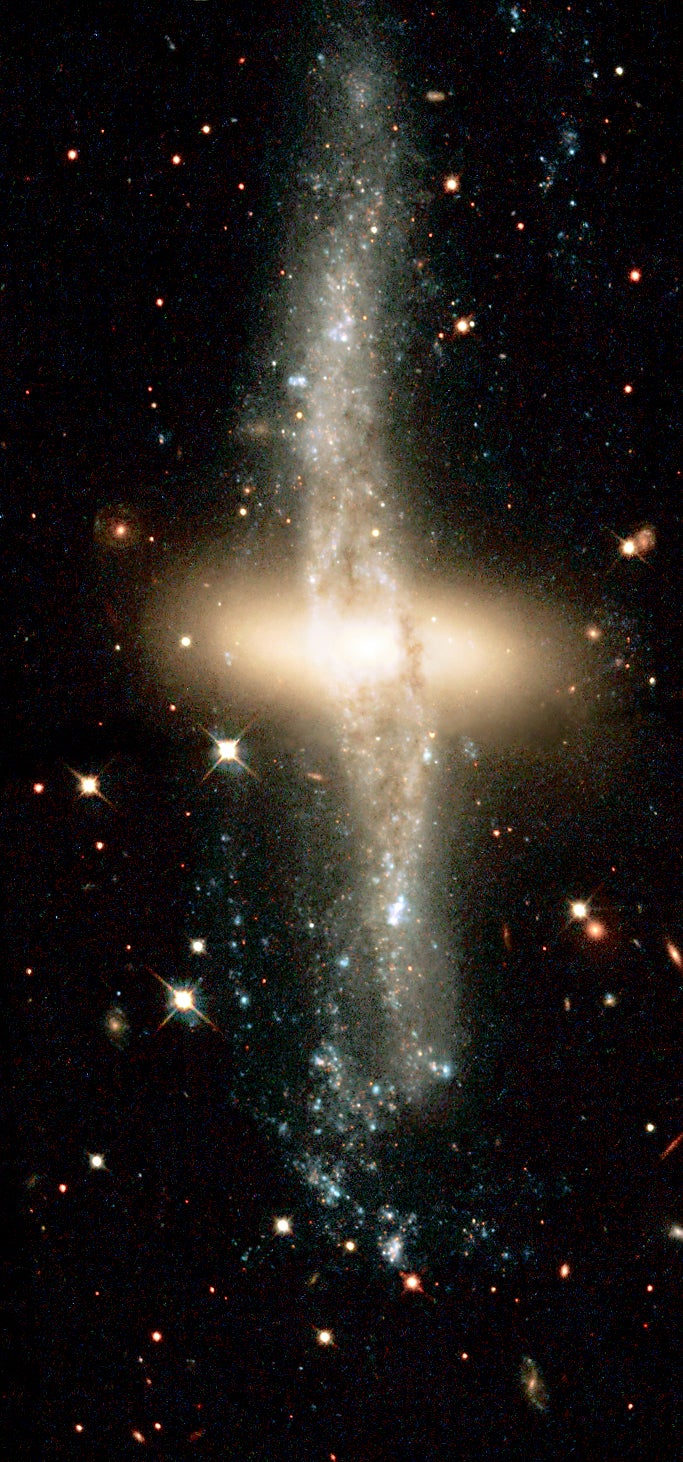
Astronomers attempt to “weigh” the universe in a variety of ways. They observe the effects of dark matter on astronomical objects that vary from small to large.Dark matter was posited by Dutch astronomer Jan Oort in the 1930 when he studied star motions in the Sun’s neighborhood. Because the galaxy was not flying apart, he reasoned, enough matter must reside in the disk to keep the stars from moving away from the galaxy’s center. Oort postulated that in the Sun’s neighborhood, three times as much dark matter existed as bright matter.Stronger evidence came later as astronomers examined the luminous disks and halos of galaxies. By studying galactic rotation curves, astronomers can glimpse how some dark matter is distributed.The process works like this: Newton’s law of gravity says stars revolving about the center of a galaxy should slow dramatically the farther away they are from the galactic center. But the rotation curves of galaxies are “flat,” meaning the stars in an individual galaxy orbit at a steady velocity independent of how far from the galaxy’s center they are. The most logical explanation for this is that massive spherical halos of dark matter surround the visible matter in galaxies.
 Bringing the universe to your door. We’re excited to announce Astronomy magazine’s new Space and Beyond subscription box – a quarterly adventure, curated with an astronomy-themed collection in every box. Learn More >>.
Bringing the universe to your door. We’re excited to announce Astronomy magazine’s new Space and Beyond subscription box – a quarterly adventure, curated with an astronomy-themed collection in every box. Learn More >>.
Other clues for the existence of dark matter come from studying galaxy clusters. Also in the 1930s, American astronomer Fritz Zwicky deduced that much larger clouds of dark matter exist in the Coma cluster of galaxies, about 300 million light-years from Earth. By looking at the Doppler shifts of individual galaxies in the cluster, Zwicky concluded that 10 times more mass than was detected via visible light must be present to keep the galaxies gravitationally bound.One of the great mysteries of recent decades centers on a very basic question about dark matter: What exactly makes up this stuff? Over the years, scientists have proposed many different possibilities, and each has its own strengths and weaknesses in terms of explaining astronomers’ observations. They include massive numbers of normal neutrinos; MACHOs (massive compact halo objects) such as brown dwarfs, neutron stars, and black holes; and WIMPs (weakly interacting massive particles) such as exotic particles, axions, massive neutrinos, and photinos.Whatever it consists of, dark matter carries enormous implications for the structure and future of the cosmos, as it accounts for 26 percent of the universe’s total mass-energy. About 85 percent of the matter in the universe consists of both baryonic and non-baryonic dark matter. (Baryons are particles consisting of three quarks that interact through the strong nuclear force – including protons and neutrons.)Of non-baryonic dark matter, two candidates exist: hot dark matter (HDM) and cold dark matter (CDM). The “temperature” in each model refers to the particles’ velocities. Neutrinos represent the likeliest HDM candidate, while WIMPs are the favorite of the CDM possibilities. MACHOs, which are a form of baryonic dark matter, only constitute a small percentage of the total.
An HDM-dominated universe would suggest little matter exists between clusters of galaxies; however, observations over the past decade have shown this is not the case, largely discrediting the HDM model of the universe.Had massive numbers of neutrinos been created in the early universe, they likely would have smoothed out the ripples in the cosmic microwave background.
This didn’t happen. The vast majority of dark matter, therefore, must exist in some form of CDM. The odds are leaning toward massive, exotic, relatively slow-moving particles. But astronomers must make great strides before we’ll know the exact identity of dark matter, one of the century’s greatest astronomical mysteries.









